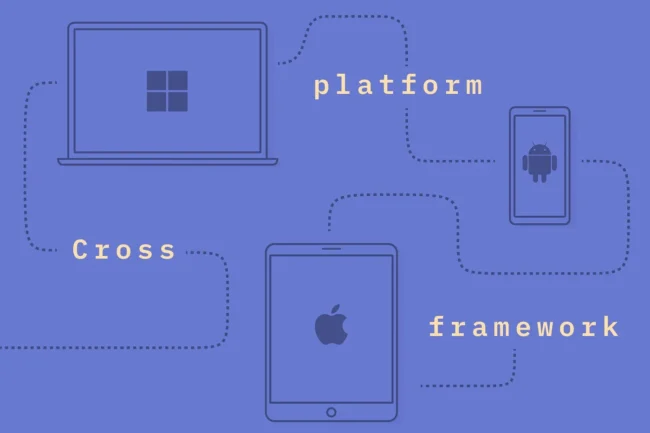As mobile technology continues to evolve, we as developers are faced with the challenge of creating mobile apps that work great on all platforms. Traditionally, this has meant building separate apps for each platform, which is very time consuming and costly. However, with the rise of cross-platform mobile development, developers can now write code once and deploy it across multiple platforms.
What Is Cross-Platform Mobile Development?

Cross-platform mobile development refers to the process of writing code once and deploying it across multiple platforms, such as iOS and Android. This is achieved using frameworks and tools that allow developers to write code in a single codebase and then compile it for multiple platforms.
Cross-platform development offers several advantages over native development, including:
- Cost Savings: With cross-platform development, developers can write code once and deploy it across multiple platforms, reducing the time and cost required to develop separate app for each platform
- Wider Audience: By deploying an app on multiple platforms, developers can reach a wider audience, increasing the app’s potential user base
- Consistent User Experience: Cross-platform development allows developers to ensure that users have a consistent experience across multiple platforms, improving the overall user experience
However, cross-platform development also has some limitations, including:
- Performance Issues: Cross-platform apps may not perform as well as native apps, particularly for complex apps that require heavy processing or graphics
- Limited Access To Native Features: Cross-platform development may not provide access to all of the native features of each platform, limiting the app’s functionality
- Development Limitations: Cross-platform development may limit the development process, as developers may need to compromise on certain features or design elements to ensure compatibility across multiple platforms
Cross-Platform Development vs. Native Development

To better understand the pros and cons of cross-platform development, it’s important to compare it to native development. Native development involves building separate apps for each platform using that platform’s specific language and tools.
Native development offers several advantages, including:
- Access To Native Features: Native development provides access to all of the native features of each platform, allowing developers to create apps with rich functionality and design
- Better Performance: Native apps generally perform better than cross-platform apps, particularly for complex apps that require heavy processing or graphics
- Better User Experience: Native apps can provide a better user experience, as they are designed specifically for each platform, taking into account the unique features and design elements of each platform
Native development has limitations as well:
- Time And Cost: Developing separate apps for each platform can be time-consuming and costly, as developers need to learn multiple programming languages and use platform-specific tools
- Limited Audience: Developing separate apps for each platform may limit the app’s audience, as users may only be able to access the app on one platform
- Inconsistent User Experience: Developing separate apps for each platform may result in inconsistent user experience, as users may have different experiences depending on the platform they are using
Common Tools and Frameworks For Cross-Platform Development
To make cross-platform development easier, there are several tools and frameworks available that allow developers to write code once and deploy it across multiple platforms. Here are some of the most common ones:
- React Native: React Native is a popular framework for building cross-platform apps using JavaScript and React; a popular JavaScript library for building user interfaces. It allows developer to write code once and deploy it on both iOS and Android
- Xamarin: Xamarin is a cross-platform development tool that uses C# to build apps for iOS, Android, and Windows. It allows developers to share code between platforms, reducing development time and cost
- Flutter: Flutter is a popular framework for building cross-platform apps using Dart: a programming language developed by Google. It allows developers to create beautiful and fast apps that work seamlessly across multiple platforms
- Ionic: Ionic is a popular open-source framework for building cross-platform mobile apps using web technologies such as HTML, CSS, and JavaScript. It allows developers to create hybrid apps that work on both iOS and Android
When To Choose Cross-Platform Over Native Development

Choosing between cross-platform and native development depends on several factors, including the app’s complexity, budget, and timeline.
Here are some scenarios where cross-platform development may be the better option:
- Limited Budget: If you have a limited budget, cross-platform development can be a cost-effective solution as it allows you to write code once and deploy it on multiple platforms
- Tight Timeline: If you need to develop an app quickly, cross-platform development can help you save time as you don’t need to write separate code for each platform
- Simple Apps: If your app is simple and doesn’t require access to many native features, cross-platform development can be a good option
- Maintenance: If you need to maintain your app on multiple platforms, cross-platform development can be a more efficient solution as you can make changes to the codebase once and deploy it across all platforms
However, there are also scenarios where native development may be the better option, such as:
- Complex Apps: If your app requires access to many native features or requires heavy processing or graphics, native development may be the better option as it can provide better performance
- Design: If your app requires a unique design that is specific to each platform, native development may be the better option as it allows you to design the app specifically for each platform
- Budget: If you have a larger budget, native development may be a better option as it can provide a better user experience and access to all of the native features of each platform
Conclusion
Cross-platform mobile development is a popular solution for creating apps that work seamlessly across multiple platforms. While it offers several advantages, such as cost savings and a wider audience, it also has limitations, such as performance issues and limited access to native feature.
Choosing between cross-platform and native development depends on several factors, including the app’s complexity, budget, and timeline. By weighing the pros and cons, developers can choose the best solution for their app development needs.